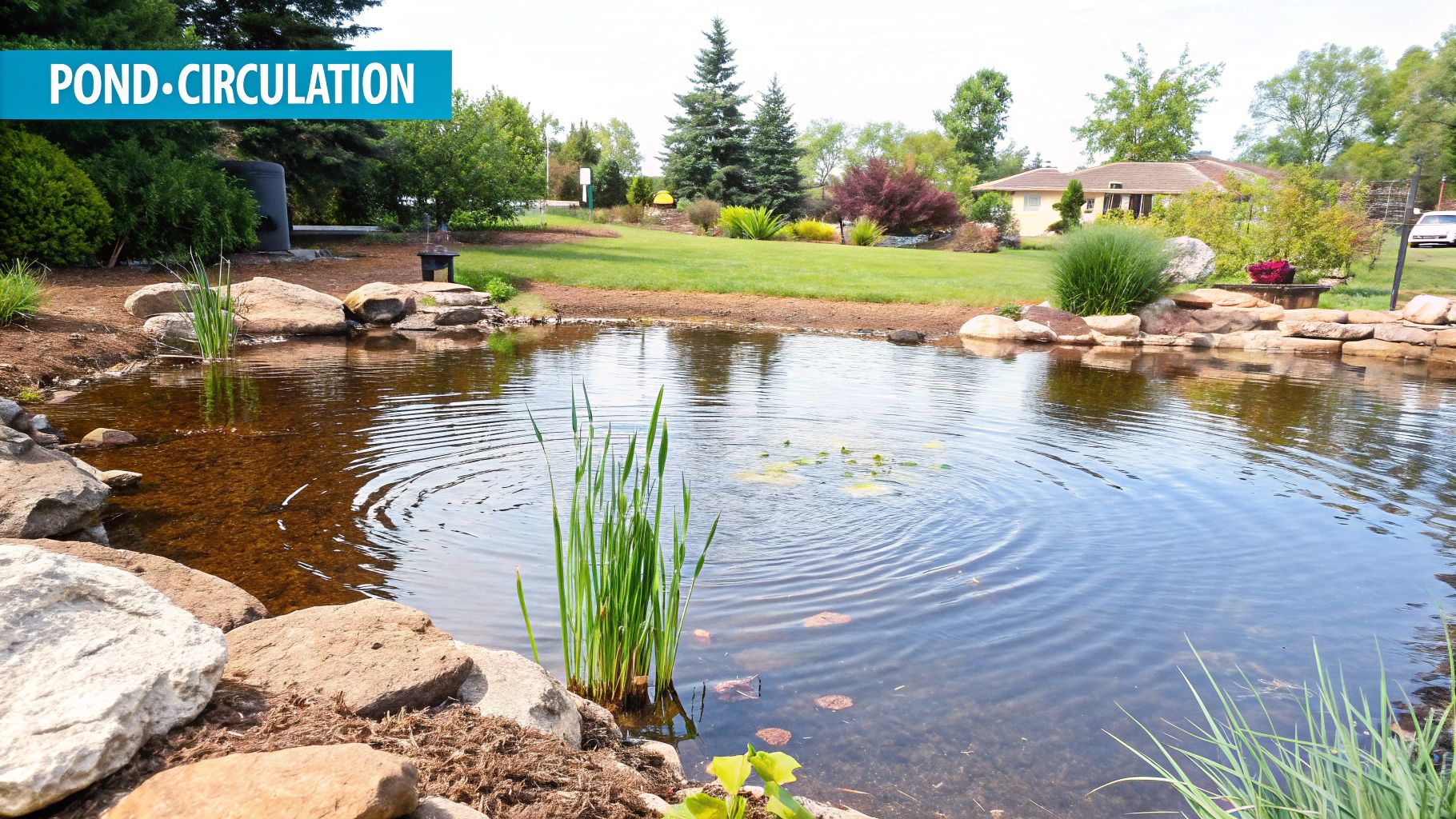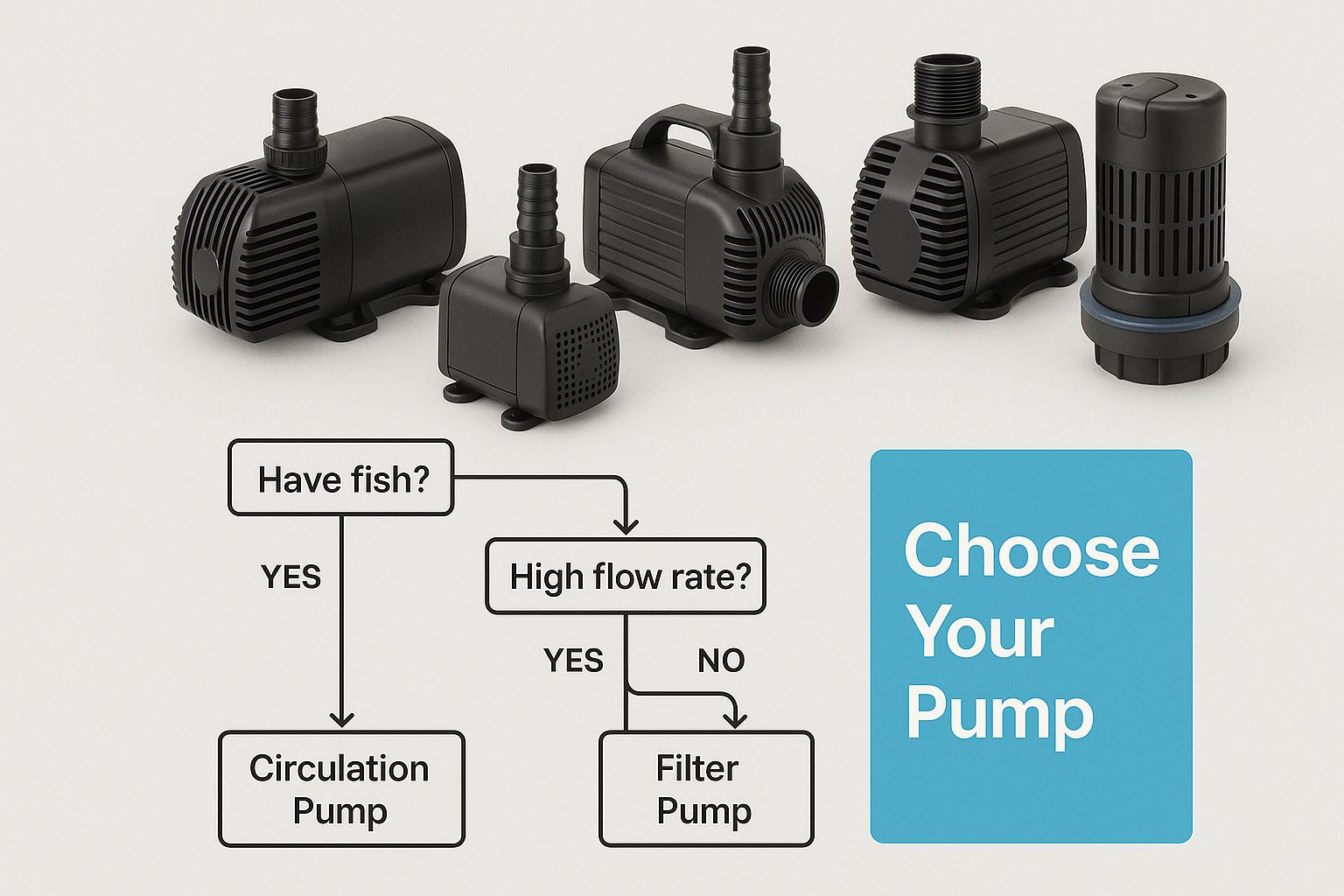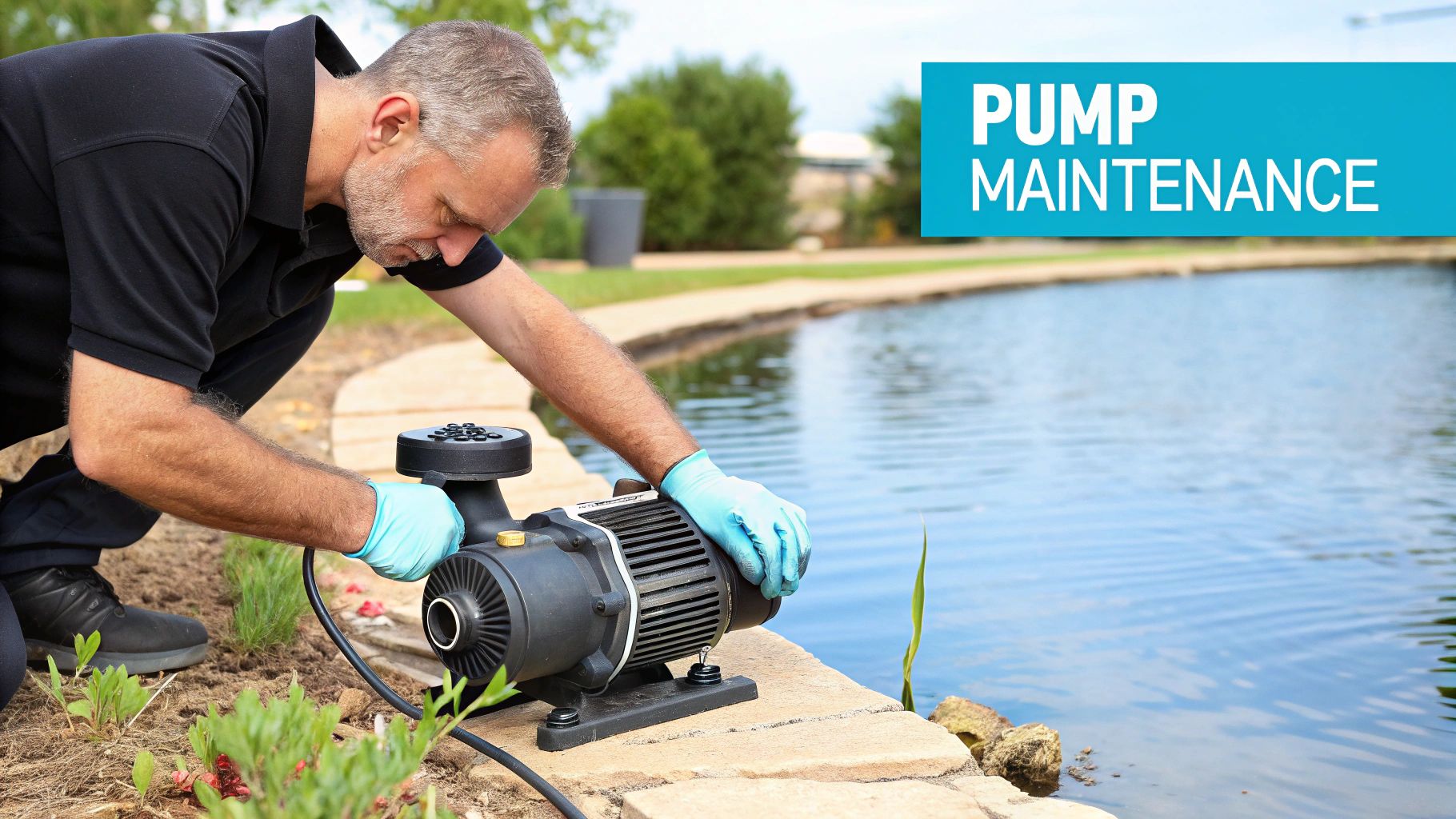A pond circulation pump is the heart of your garden oasis, ensuring water moves constantly to stay clean, clear, and healthy. Without this vital movement, a pond can quickly become stagnant, leading to algae blooms and low oxygen levels that harm your fish and plant life.
Why a Healthy Pond Needs Constant Motion

Think of your pond as a living ecosystem. A pump provides the circulation needed to move water, turning a still, lifeless body of water into a vibrant environment.
A pond circulation pump works with your filtration system. It pulls water from the pond, pushes it through the filter to remove debris and toxins, and then returns it, re-energised with oxygen. This continuous cycle is the secret to crystal clear water and healthy aquatic life.
The Dangers of Stagnant Water
When water sits still, problems begin. Without movement, oxygen levels plummet, which is dangerous for fish like koi that need high levels of dissolved oxygen.
Stagnant water also invites unwanted guests:
- Algae Blooms: Sunlight and nutrients in still water create the perfect conditions for green "pea soup" algae.
- Harmful Bacteria: Without oxygen, anaerobic bacteria can flourish, producing foul smells and byproducts.
- Pest Infestations: Still water is a magnet for mosquitoes and other pests.
A healthy pond needs fish, plants, rocks, filtration, and circulation. Lacking oxygen and circulation, it slowly gets overloaded with nutrients and weeds, which harms wildlife and plant life.
A pond circulation pump is a crucial investment in the biological stability of the entire ecosystem. It ensures a balanced environment where fish, beneficial bacteria, and plants can flourish in clean, oxygen-rich water.
Choosing the Right Pond Pump for Your Setup
Picking the perfect circulation pump comes down to your specific setup. The first decision is between two main types: submersible and external pumps. Each is designed for different kinds of ponds.
Submersible pumps are common in small to medium-sized garden ponds. Placed directly in the water, they are hidden from sight, making them a great choice for a natural look. They are also generally simpler to install and more affordable upfront.
External pumps are powerhouses that sit outside the pond in a dry, safe location like a pump house. These are built for large koi ponds or ponds with impressive water features like tall waterfalls. While they require more complex plumbing, they are often more energy-efficient for moving large volumes of water and are easier to access for maintenance.
Key Performance Metrics Explained
To choose wisely, you need to understand two key terms: flow rate and head height.
-
Flow Rate (LPH/GPH): This is how much water the pump can move in an hour, measured in Litres Per Hour (LPH) or Gallons Per Hour (GPH). A small pond may only need a gentle current, but a large koi pond with a waterfall needs a much higher LPH.
-
Head Height (or Max Head): This is the maximum vertical height the pump can push water. If your waterfall is 1.5 metres high, you need a pump with a head height greater than 1.5 metres. As height increases, flow rate drops, so always check the manufacturer's performance chart.
This diagram offers a quick visual guide.

As you can see, it boils down to size and features. Larger, more complex ponds benefit from an external pump, while smaller setups are fine with a submersible model.
Key Takeaway: The best pump is not the most powerful one, but the one matched to your pond's volume, filtration system, and water features. An oversized pump wastes electricity, while an undersized one will struggle to keep your pond healthy.
Comparing Your Pump Options
Deciding between a submersible and an external pump is a key step. This comparison table breaks down the main differences to help you decide.
Comparing Submersible and External Pond Pumps
| Feature | Submersible Pump | External Pump |
|---|---|---|
| Best For | Small to medium ponds (under 10,000 litres) | Large ponds, koi ponds, and tall waterfalls |
| Installation | Simple; place in water and plug in | More complex; requires dry housing and plumbing |
| Maintenance | Tricky to access for cleaning | Easy to access for maintenance and repairs |
| Initial Cost | Lower | Higher |
| Energy Use | Less efficient for high-flow jobs | More energy-efficient for moving large volumes of water |
| Aesthetics | Hidden completely underwater | Must be housed or concealed near the pond |
For larger systems needing reliable performance, an external model like the Performance Pro Cascade Pump 13000 is designed to handle high flow rates efficiently. Taking time to consider these points will pay off with a healthier pond.
How to Calculate the Perfect Pump Size

Sizing your pond circulation pump correctly is the most important decision. A pump that's too weak results in a murky pond. One that's too powerful just wastes energy and money.
The secret is to match the pump’s flow rate to your pond's needs. A good rule of thumb is that your pump should circulate the entire volume of your pond’s water at least once every hour.
To do this, you first need to calculate your pond's volume.
Calculating Your Pond Volume
For square or rectangular ponds, the formula is straightforward. Measure the average length, width, and depth of your pond in metres.
Length (m) x Width (m) x Depth (m) = Volume in Cubic Metres (m³)
Once you have the volume in cubic metres, convert it to litres.
Simple Conversion: 1 cubic metre (m³) holds 1,000 litres of water. Multiply your result by 1,000 to find your pond’s total volume in litres.
For instance, a pond that is 3m long, 2m wide, and 1.5m deep would have a volume of 9 cubic metres, which is 9,000 litres. Following the rule, you'd need a pump with a flow rate of at least 9,000 LPH.
Adjusting for Real-World Factors
The "once per hour" rule is a baseline. Several factors can increase demand on your pump, meaning you may need more power. You might need to increase your flow rate if your pond has:
- Heavy Fish Stock: Koi produce a lot of waste and need highly oxygenated water. For a koi pond, aim to turn over the water every 30 to 45 minutes, which doubles your required flow rate.
- Intense Sunlight: Ponds in direct sun are more prone to algae. Increasing your circulation by about 25% helps combat this.
- Waterfalls or Streams: Pushing water uphill for a feature requires significant power. You must account for the head height and friction loss from pipework. Always check the pump’s performance chart to ensure it delivers the required flow at your specific head height.
For a larger pond with demanding features, a powerful and reliable unit like the Superfish Pond Eco 15500 is built to handle higher volumes. Calculating your needs accurately sets you up for a healthy, clear pond.
A Practical Guide to Pump Installation
With your perfectly sized pond circulation pump, the final step is correct installation. Where and how you position your pump directly impacts its efficiency and your pond's health.
The main goal is to maximise water turnover and eliminate "dead spots." For a submersible pump, place it at the opposite end of the pond from where the water returns (e.g., from your filter or waterfall). This creates a pond-wide current for complete circulation.
Positioning for Peak Performance
When placing a submersible pump, don't just drop it in the deepest part. Raise it slightly off the pond floor with bricks or a flat stone. This prevents it from sucking up thick sludge, which can clog the intake and strain the motor.
If you're using an external pump, choose a dry, sheltered spot as close to the pond as possible. Ensure the housing has plenty of ventilation to prevent overheating and is easily accessible for maintenance.
Crucial Safety Note: All pond electricals, especially the pump, must be connected to a power source protected by a Ground Fault Circuit Interrupter (GFCI), also known as a Residual Current Device (RCD). This is an essential safety device that instantly cuts power if it detects a fault, protecting you from electric shock.
Connecting Pipework and Ensuring Safety
Once the pump is in position, connect the pipework. Use smooth, rigid pipes where possible. Corrugated or flexible hosing creates drag that can reduce your flow rate by 20% or more. Ensure every connection is secure and watertight.
For those building a new pond, our guide on how to join a pond liner has invaluable tips for a professional finish.
Finally, always follow the manufacturer's instructions for the electrics. Run the power cable through a protective conduit to shield it from accidental damage. Correct installation saves headaches later and ensures your pump runs safely and efficiently.
Simple Maintenance for a Long-Lasting Pump
A little proactive care for your pond circulation pump goes a long way. Routine maintenance helps prevent clogs, reduce motor strain, and extend the life of your equipment. A few minutes of attention is better than a failed pump and a murky pond.
The Essential Cleaning Checklist
The most common cause of pump failure is a blockage. Debris like leaves and algae can get sucked into the pump, restricting water flow and forcing the motor to overwork, which can lead to burnout.
Follow this simple routine:
- Safety First: Always disconnect the pump from the power supply before handling it.
- Access the Pump: Carefully remove the pump from the pond.
- Clean the Intake Screen: Use a stiff brush and pond water to scrub away any debris from the outer casing.
- Inspect the Impeller: Once the screen is off, check the impeller (the fan-like part) and gently remove anything tangled around it.
A clean pump is an efficient pump. Keeping the intake and impeller clear ensures maximum flow rate with minimum effort, leading to better water quality and lower energy bills.
Seasonal Care and Replacement Parts
Your maintenance routine will change with the seasons. A quick clean every month during summer is a good habit. In autumn, check it more often as leaves fall. For winter, you might bring the pump indoors for a thorough clean and safe storage.
Over time, parts like the impeller or O-rings can wear out. Finding replacements is often a cost-effective fix. Instead of buying a whole new pond circulation pump, a simple part replacement can restore your system. The same principles apply to other pumps, too. For example, popular models like the Medo LA80-B air pump also have service kits available to keep them running efficiently.
Even the most reliable pump can have an off day, but the fix is often simple. Most problems are due to power issues, weak flow, or strange noises.
Pump Will Not Start
If your pump is dead, the problem is often related to the power supply. Check these points first:
- Check the Power Source: Is the pump securely plugged in? Has the RCD (Residual Current Device) tripped?
- Inspect the Cable: Look for any visible damage to the power cable.
- Clear the Impeller: Disconnect the power and check for any debris physically blocking the impeller from turning.
Weak Water Flow or Strange Noises
A drop in water pressure or a rattling sound often points to a blockage. A clog forces the motor to work harder, causing strain and noise.
A clogged pump is a struggling pump. Reduced flow puts stress on the motor and can lead to premature failure. Regular inspections for blockages are the best defence.
Start by cleaning the intake screen where most debris gets trapped. If that doesn't work, check the impeller housing and your pipework for any kinks or blockages.
For a more comprehensive look, find detailed advice by troubleshooting common pond pump issues in our dedicated article. Following these steps can help you solve most minor problems.
Your Pond Pump Questions Answered
Here are answers to some of the most common questions from pond owners.
How Much Does It Cost to Run a Pond Pump?
A pump's running cost depends on its wattage. Modern, energy-efficient pumps can run 24/7 for a low cost. For example, a small 20-watt pump running continuously uses about 14.4 kilowatt-hours (kWh) per month. Check your pump's wattage and your electricity bill's price per kWh to calculate your specific cost.
Can I Switch My Pump Off at Night?
It's strongly advised not to. Your pond’s biological filter relies on a constant flow of oxygenated water to keep its beneficial bacteria alive. Turning the pump off, even for a few hours, can starve these bacteria and harm your water quality. Continuous operation is key to a stable, healthy ecosystem.
Continuous circulation is non-negotiable for pond health. The filtration system and fish depend on the constant movement and oxygenation that a 24/7 pond circulation pump provides.
What Is the Best Way to Protect My Pump in Winter?
In the UK, it's wise to take precautions against freezing temperatures. You can either lift the pump higher in the water column, away from the freezing surface, or remove it entirely. If you take it out, clean it thoroughly and store it in a bucket of water in a frost-free place like a shed. This keeps the seals moist and prevents them from cracking.
For all your pond care needs, from expert advice to the best equipment, Hatton Koi provides a complete selection to help you create and maintain a thriving aquatic environment.
Explore our full range of pond pumps and accessories at Hatton Koi.

